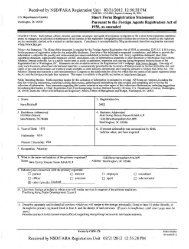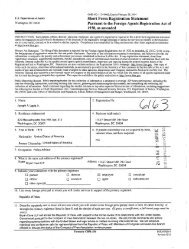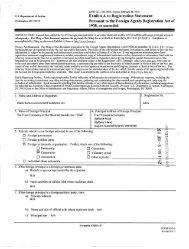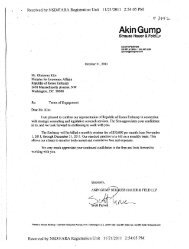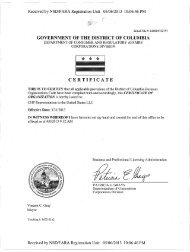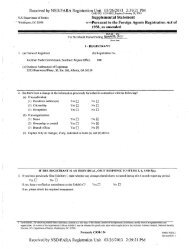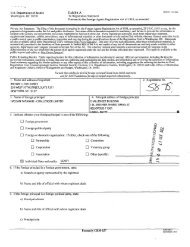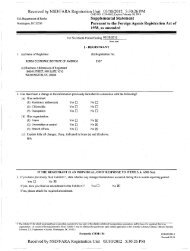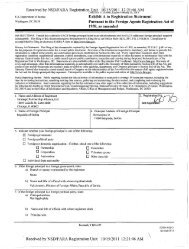Supplemental Statement - FARA
Supplemental Statement - FARA
Supplemental Statement - FARA
You also want an ePaper? Increase the reach of your titles
YUMPU automatically turns print PDFs into web optimized ePapers that Google loves.
Received by NSD/<strong>FARA</strong> Registration Unit 08/23/2012 9:59:28 AM<br />
MARKET ^^ights<br />
•"4 Continued from page 1<br />
Tunisia's Edible<br />
Oil Market:<br />
Setting pace<br />
for a new era<br />
drafting of a constitution will take several<br />
months. During this time, there will be no<br />
major economic boom as foreign<br />
investors will remain cautious about<br />
Tunisia until a permanent government<br />
and regulatory framework are in place.<br />
Tunisia currently faces several<br />
challenges that may threaten the viability<br />
of its development strategy in the future.<br />
First, unemployment, particularly among<br />
educated Tunisians, remains high at<br />
around 15% on average in recent years.<br />
Second, there is still high regional<br />
inequality, with increased spending on<br />
social programmes, health and education<br />
needed in order to reduce poverty in the<br />
rurai areas. A continuous high influx from<br />
the rural areas may increase the fragility<br />
of the infrastructure and social structure<br />
of the cities. Third, although Tunisia's<br />
financial sector has been liberalised<br />
under liberalisation and reform<br />
programmes in early 1990s, it failed to<br />
mobilise significant domestic savings.<br />
Hence, access to credit for small- and<br />
medium-scale businesses is low.<br />
Tunisia's medium-term outlook is<br />
positive overall under the current<br />
domestic and external conditions. Real<br />
GDP growth in the range of 4.2% to 5.6%<br />
is foreseeable under the current<br />
domestic and external conditions. This<br />
outlook is predicted on continued prudent<br />
macroeconomic policies, low inflation<br />
and further progress in structural reforms<br />
which are expected to improve<br />
productivity. However, the positive<br />
medium-term outlook hinges on demand<br />
in the EU market not faltering sharply, oil<br />
prices, absence of repetitive droughts<br />
and a good security condition in the<br />
region to encourage tourists to continue<br />
coming and FDI flow. To sustain a 6%<br />
growth in the medium term, an<br />
acceleration of reforms and a recovery of<br />
private domestic investment will be<br />
necessary.<br />
Tunisia's economy recorded an annual<br />
increase in GDP of over 4.5% in 2008<br />
The country has since that time<br />
experienced an economic slowdown, in<br />
particular a significant decline in its<br />
exports as the economies of its major<br />
trading partners slowed down (Table 1).<br />
Tourism, agriculture and services are<br />
particularly important for Tunisia's<br />
economy, accounting for over 90% of the<br />
GDP. Its close trade relationship with the<br />
European Union (EU), including an<br />
agreement to liberalise trade, has been<br />
very positive for the Tunisian economy,<br />
with more than 70% of its exports going<br />
to the EU. However, economic<br />
contraction in the EU has reduced<br />
imports and is leading to a significant<br />
slowdown in the economic growth of<br />
Tunisia.<br />
The 2011 political turmoil and unrest has<br />
shifted Tunisia's economic landscape<br />
due to business disruptions. However,<br />
owing to early success in the country's<br />
democratic transition and pledges to<br />
embark on a market-orientated policy<br />
framework, Tunisia will be able to break<br />
out of its stagnation period experienced<br />
during political turmoil and unrest. World<br />
Bank forecasts for 2012 and 2013 have<br />
been revised up to 4.2% and 5.6%<br />
respectively, from 2.3% and 4.9%<br />
previously. Tunisia will still have to cope<br />
with the real effects of the declinefiri"'<br />
European demand for the next two years,<br />
which may further affect the production of<br />
clothing items and auto parts. The<br />
economy is suitably diversified and<br />
measures aimed at limiting the negative<br />
effects of the crisis have been adopted.<br />
First, there were interventions in favour<br />
of the banking and financial system, after<br />
which measures were implemented in<br />
favour of enterprises that cause exports<br />
to rise and increase domestic demand as<br />
well.<br />
On the other side, Tunisia has a fragile<br />
natural environment with limited natural<br />
resources. Some 83% of its water is<br />
already mobilised and groundwater is<br />
over-extracted in most agricultural areas.<br />
Poor land management is also<br />
increasing land degradation through<br />
water-logging and salinity level.<br />
HMD ifeIHgHfeSS'riC'JMWiht.i:.<br />
Oils and Fats Situation<br />
With a population of about 10.5 million,<br />
Tunisia not only has been producer and<br />
exporter of edible oil but also an importer<br />
of oils and fats. It is currently one of the<br />
largest producers of olive oil, contributing<br />
about 4% of the world production and 8%<br />
of the world exports. Despite being the<br />
exporter of edible oils for decades,<br />
Tunisia needs to import other edible oils<br />
in order to meet local consumption for<br />
cooking and frying purposes. The<br />
production of olive oil has regressed in<br />
recent years due to drought, resulting in<br />
reduction of exports and the country had<br />
to import edible oils and fats for domestic<br />
needs.<br />
Tunisia is a predominantly a liquid oil<br />
market and is considered to be small<br />
market for palm oil, which nevertheless is<br />
an important growing commodity in North<br />
Africa because of vibrant economic<br />
conditions that are spurring the<br />
development of the food industry.<br />
Tunisia's edible oil supply is derived<br />
mainly from locally produced olive oil and<br />
three major imported oils, soybean palm<br />
and corn. Tunisian consumption of oils<br />
and fat was 331,800 MT in 2009, with<br />
soybean oil recording the highest<br />
consumption at 60%, followed by palm oil<br />
at 15%. During drought periods, the<br />
country relies heavily on imported<br />
agricultural commodities while the years<br />
of rainfall favourable to domestic crops<br />
bring about a drop in the import of<br />
agricultural products, including soft oils.<br />
On the import side, Tunisia continues to<br />
rely heavily on soybean and corn oils to<br />
meet household needs. These<br />
up-and-down scenarios in the<br />
supply-demand of soft oils in Tunisia, as<br />
illustrated by import, statistics, also<br />
explain the vulnerability of the<br />
high-priced soft oils in Tunisia, which in<br />
turn has given some market access<br />
advantage to palm oil (Table 2). In 2010,<br />
Indicator | 2008 | 2009 | 2010 | 2011(p) |2012(p)| 2013(p) |2014(p) |2015(p)<br />
CPI Inflation 7-5:i 77 :3.5ff~3:T ; 7 3.5 2.7 \'2.6<br />
'•"*!E!SK=




